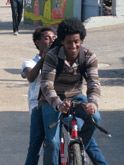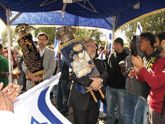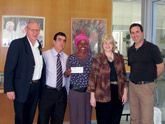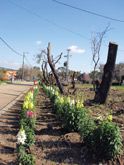
 According to a Media Line article, Dr. Chaim Peri, director emeritus of the 57-year-old institution, said his greatest fear was how the destruction and displacement would affect the children—at-risk children who come to this special home as refugees, immigrants, and orphans or from dysfunctional homes. “What I was most fearing was that all of these kids from orphanages in Eastern Europe, who have been abandoned once and now see their homes in ruins, what is going to happen to all the processes and all the love and all the trust that we have instilled in them?”
According to a Media Line article, Dr. Chaim Peri, director emeritus of the 57-year-old institution, said his greatest fear was how the destruction and displacement would affect the children—at-risk children who come to this special home as refugees, immigrants, and orphans or from dysfunctional homes. “What I was most fearing was that all of these kids from orphanages in Eastern Europe, who have been abandoned once and now see their homes in ruins, what is going to happen to all the processes and all the love and all the trust that we have instilled in them?”
Amazingly, the children realized that Yemin Orde wasn’t buildings that could be burned to the ground but was people and the love they have for each other. When they returned to government-provided, temporary caravans, they did so with a joyful, grand processional returning nine Torah (Gen.–Deut.) scrolls to their synagogue.
  |
It was estimated that the campus sustained around US $8.5 million in damages, only half of which will be covered by insurance. Though it is livable, it will likely take two years before everything is back to normal. So, in March, BFP CEO Rebecca Brimmer and other staff made a visit to the 77-acre campus to hand over a check for around US $57,000—a blessing from our BFP donors around the world who responded to our call for help to restore the fire’s damages. (Another US $3,000 was used immediately on the first day of the fire for food and supplies for evacuated residents.)
In other parts of the world, Israel’s youth villages would probably be referred to as orphanages or boarding schools, but “youth village” is actually a much friendlier term. The first one—though far from today’s model—was established in 1870, but it was only an agricultural school, which was financed by Baron Rothschild. In the 1930s, the British Mandate opened boarding schools for children escaping the Holocaust in Europe.
Then in the 1940s and 50s, many villages were established to take care of children coming in from the mass immigration that was taking place at the time. It was during this time, in 1953, when Yemin Orde began. Dr. Peri writes: “Their initial purpose was to enhance values and behavior codes essential to the development of and reflecting the core beliefs of the new state.” From the 1960s to the 1980s, children suffering from “inner brokenness, helplessness, and social alienation” were included.
Today, there are 60 youth villages for 18,000 children (only half of the number of children that social workers say need such a home). Of all of them, Yemin Orde has become a model that others follow. They call this model “The Village Way,” which “allows for a structural environment to endow children with recognition and pride in their past, and a sense of direction and security about their future.” They provide tools “to do more than survive, but thrive and reach their full potential” so they leave as “whole” adults, not spectators but active participants who make the world a better place.
This model attempts to create an environment that goes back to the past “when people lived in villages and tribal communities, surrounded by their extended families,” where “children grew and developed within a balanced arena, where parents and other significant adult figures modeled and imparted an emotionally coherent set of qualities, connections, skills, and beliefs.”
Just like the African proverb, “It takes a village to raise a child,” Yemin Orde has its village of adult figures: 50 full-time teachers and 42 part-time teachers, 22 full-time professional counselors and 6 social workers, 5 part-time psychologists, 12 housemothers, 10 full-time and 2 part-time administrative staff, 9 full-time and 1 part-time maintenance staff.
This is not just home until they graduate from high school. During their two to three-year military service, they receive care packages, and when they need financial support, they are provided with housing stipends and loans. This is a home for life, as close to a regular family unit as is possible. A 65-unit graduate house is on the grounds where graduates can come back home for a visit anytime they want. In fact, the graduates often choose to have weddings or reunions there.
The Yemin Orde model is so successful that a Haifa University study revealed that 90% of its graduates become satisfied, well-adjusted citizens, university students, civic leaders, and professionals. According to a Forward article, “Almost one in two male graduates [in the army] becomes an officer or serves in a combat unit, while the national average is around 10%.” Many, now 30- and 40-year-olds, returned to brave the flames, evacuate the students, coordinate firefighting efforts to protect what was left and could be salvaged, and rescued the Torah scrolls. They were not returning to their alma mater; they were returning to their home.
 We at Bridges for Peace International think you will agree that we invested your gifts wisely. Why not get better acquainted with our extended family at their Web site: www.yeminorde.org.
We at Bridges for Peace International think you will agree that we invested your gifts wisely. Why not get better acquainted with our extended family at their Web site: www.yeminorde.org.
Source: By Charleeda Sprinkle, Assistant Editor
Photo Credit: Isranet, BFP and www.yeminorde.org
All logos and trademarks in this site are property of their respective owner. All other materials are property of Bridges for Peace. Copyright © 2025.
Website Site Design by J-Town Internet Services Ltd. - Based in Jerusalem and Serving the World.